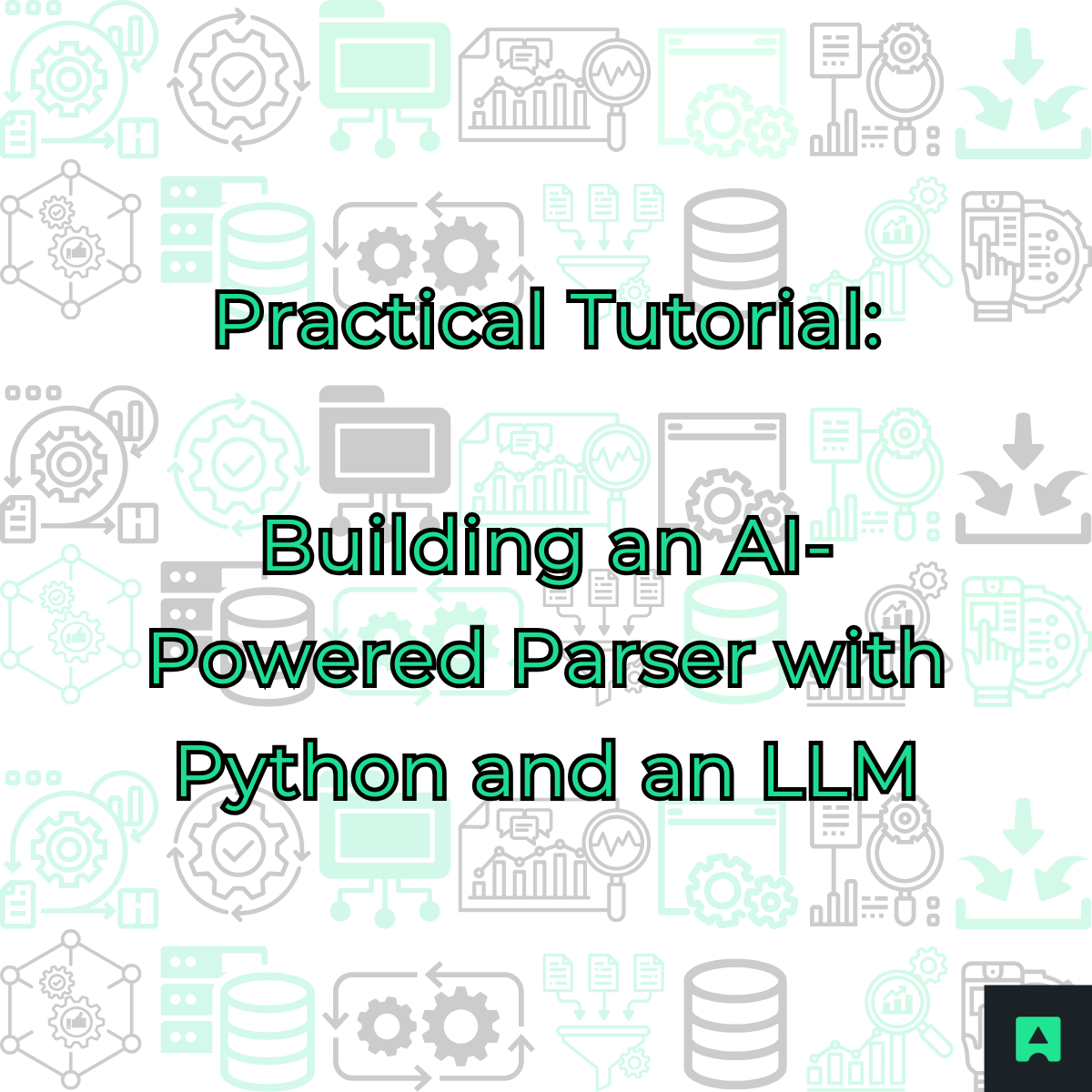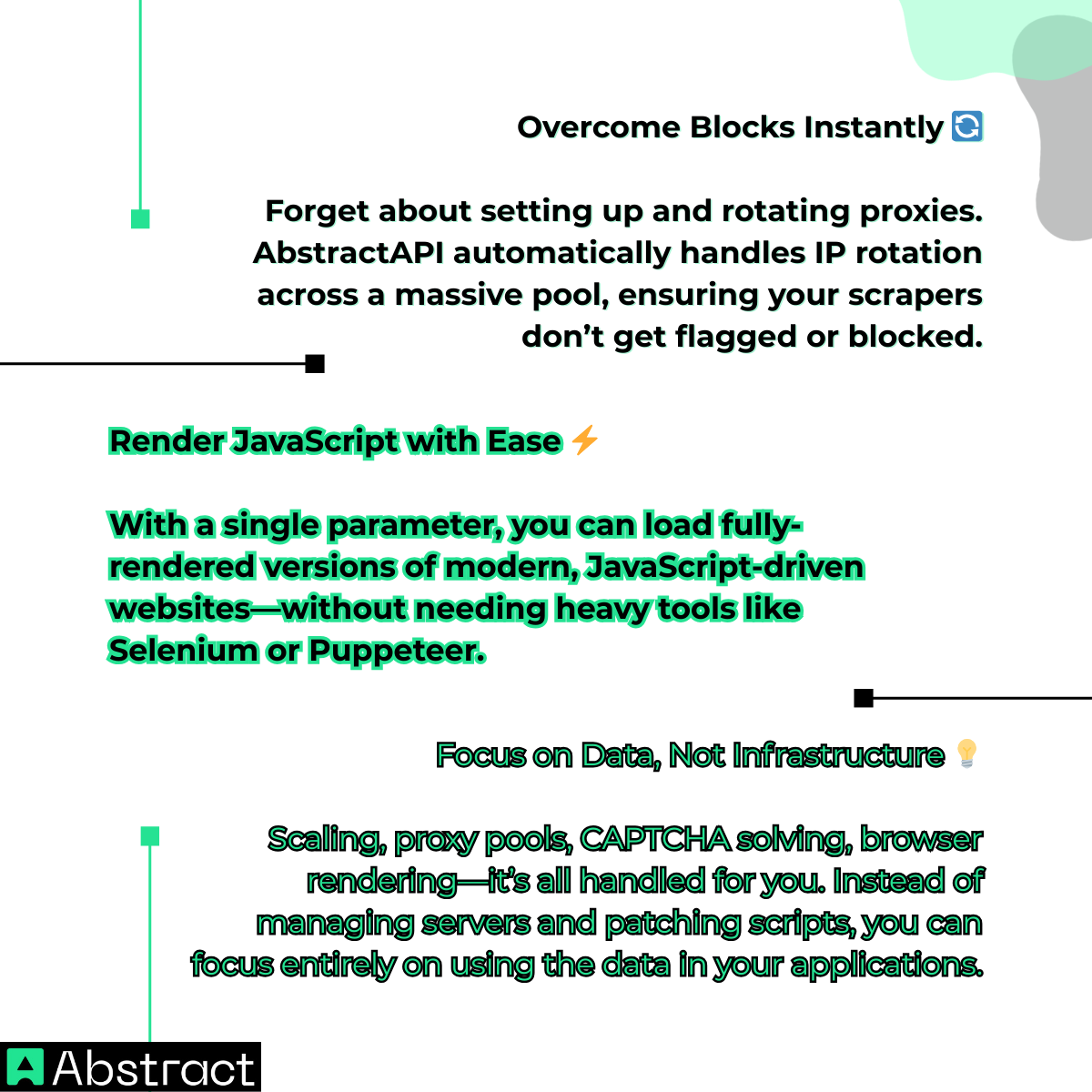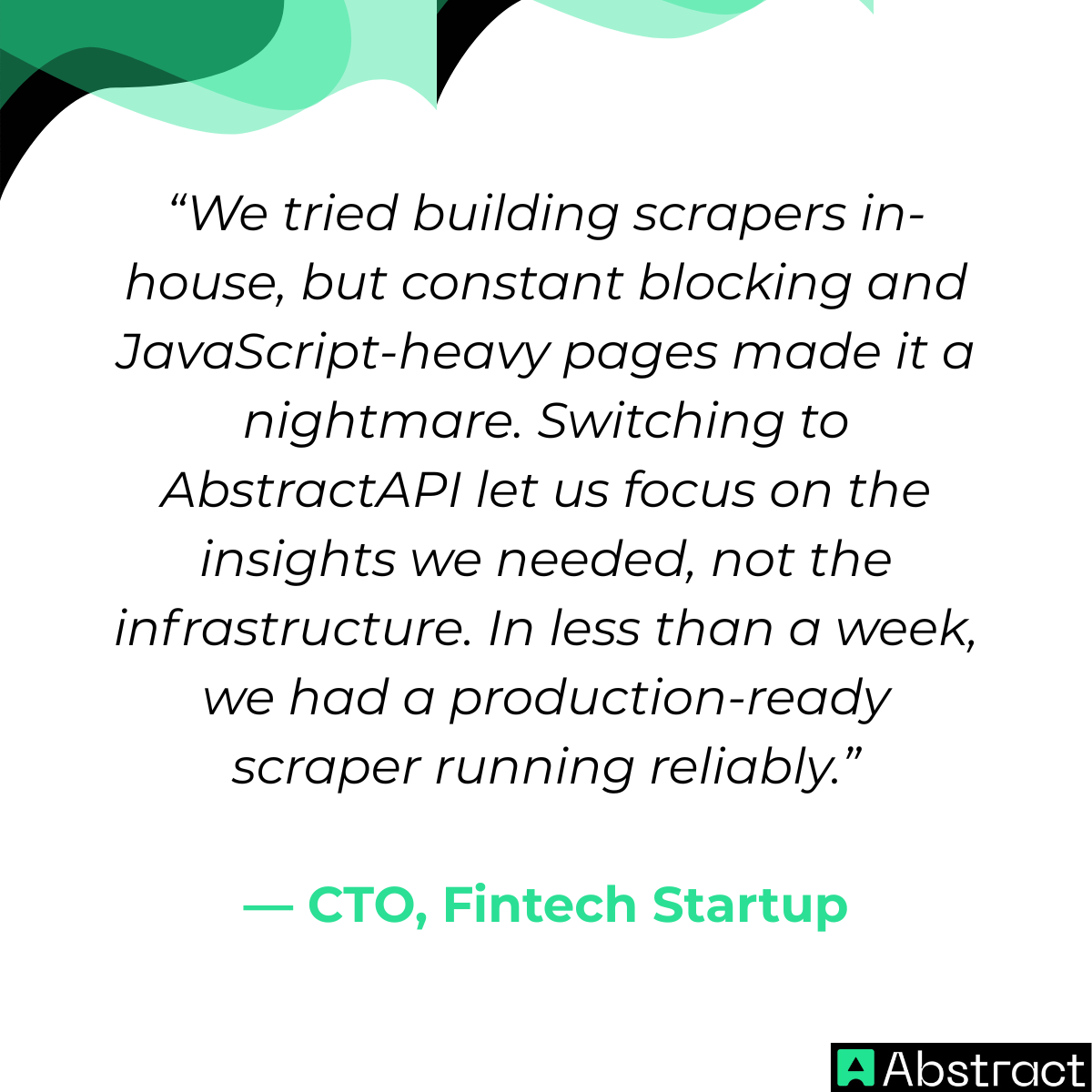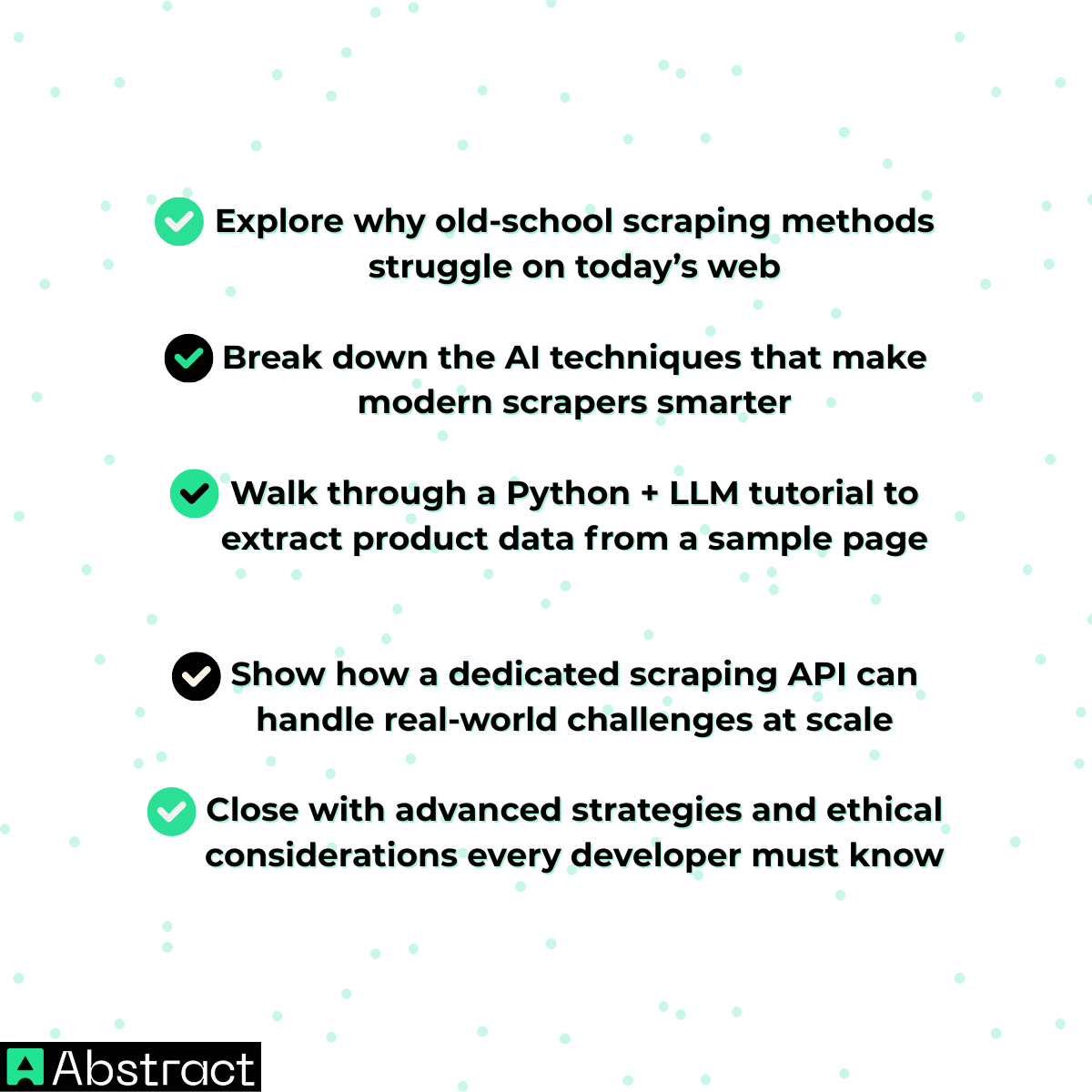Why Traditional Web Scraping Is No Longer Enough 🚧
The internet is evolving quickly, and scraping has become more complex. Let’s look at the biggest obstacles:
Dynamic Content
Many modern websites rely heavily on JavaScript frameworks like React, Angular, or Vue. Instead of sending complete HTML, they send bare-bones markup and then fetch data asynchronously with AJAX calls.
➡️ For a traditional scraper, this means the actual content (product listings, reviews, prices) never shows up in the fetched HTML. Without rendering JavaScript, the scraper sees only placeholders.
Anti-Scraping Defenses
Websites are increasingly defensive about their data. Common techniques include:
- CAPTCHAs that force human validation
- IP blocking and rate limiting to detect unusual traffic
- User-agent filtering to block “bot-like” requests
A basic scraper with a static IP and no disguise won’t last long before getting flagged.
Fragile Layouts
Even minor updates—like changing a <div class="price"> to <span class="price-tag">—can cause a scraper to fail. For developers managing dozens of scrapers, the maintenance overhead is enormous.
👉 Bottom line: scraping today’s web requires smarter tools that can adapt, interpret, and scale.
The AI Toolkit: How AI Understands the Web 🤖
Artificial intelligence solves many of these problems by approaching the web more like a human would. Here are the key techniques behind AI web scraping:
Natural Language Processing (NLP) for Contextual Extraction
NLP allows models to understand meaning in text. Instead of “look for this class name,” NLP can recognize that “$19.99” is a price or “4.5 stars” is a review rating.
Example use cases:
- Extracting product names and reviews from e-commerce sites
- Pulling contact details (emails, phone numbers) from business directories
- Identifying event dates and locations from announcements
Computer Vision for Visual Content
Sometimes, key data isn’t in plain text at all—it’s inside images, infographics, or charts. Computer vision models can “see” the rendered page:
- Extracting discount codes from promotional banners
- Reading values from graphs or dashboards
- Capturing text embedded in images via OCR (Optical Character Recognition)
Machine Learning for Adaptability
Machine learning models can learn the structure of a site and adapt when it changes. Instead of breaking with each update, the model can infer where the data has moved.
Think of it like this: a traditional scraper is a rigid recipe, while an ML-powered scraper is a flexible chef who knows how to cook even when the kitchen changes. 👨🍳
Practical Tutorial: Building an AI-Powered Parser with Python and an LLM 🐍

Now, let’s build a practical scraper that uses an LLM to extract structured data from a simple e-commerce page.
Sample HTML Page
Here’s a simplified snippet you can save as sample.html:
<html>
<body>
<div class="product">
<h1 class="title">Noise-Cancelling Headphones</h1>
<span class="price">$199.99</span>
<ul class="features">
<li>Wireless Bluetooth 5.0</li>
<li>Active Noise Cancellation</li>
<li>20-hour battery life</li>
</ul>
</div>
</body>
</html>
Step 1: Setup and Fetch
python3 -m venv scraper-env
source scraper-env/bin/activate
pip install requests beautifulsoup4 openai
import requests
# If using a live page:
url = "https://example.com/product"
response = requests.get(url)
raw_html = response.text
For testing with sample.html:
with open("sample.html", "r") as f:
raw_html = f.read()
Step 2: Clean the Noise
from bs4 import BeautifulSoup
soup = BeautifulSoup(raw_html, "html.parser")
for tag in soup(["script", "style", "header", "footer", "nav"]):
tag.decompose()
cleaned_html = soup.get_text(separator=" ", strip=True)
- This reduces irrelevant content and helps the model focus.
Step 3: Prompt the LLM
from openai import OpenAI
import json
client = OpenAI()
response = client.chat.completions.create(
model="gpt-4o-mini",
messages=[{"role": "user", "content": prompt}]
)
data = json.loads(response.choices[0].message.content)
print(data)
Step 4: Call the LLM API
from openai import OpenAI
import json
client = OpenAI()
response = client.chat.completions.create(
model="gpt-4o-mini",
messages=[{"role": "user", "content": prompt}]
)
data = json.loads(response.choices[0].message.content)
print(data)
Expected Output:
{
"product_name": "Noise-Cancelling Headphones",
"price": "$199.99",
"features": [
"Wireless Bluetooth 5.0",
"Active Noise Cancellation",
"20-hour battery life"
]
}
🎉 And just like that, you’ve built an AI-powered parser that extracts structured data without relying on brittle selectors.
From Tutorial to Production: Using a Dedicated Web Scraping API 🚀
Our Python + LLM parser is a powerful proof of concept, but it comes with limitations. In the real world, most websites won’t cooperate:
- Many rely on JavaScript rendering, meaning the essential content never appears in the raw HTML you fetch.
- Anti-bot defenses like IP blocking and CAPTCHAs will stop your script in its tracks.
- Scaling to scrape dozens or hundreds of sites would require a custom infrastructure of proxies, headless browsers, and monitoring.
In other words: while smart, our DIY scraper is not production-ready.
The Solution: AbstractAPI’s Web Scraping API
This is where a dedicated, managed solution makes all the difference. The AbstractAPI Web Scraping API doesn’t just parse HTML—it manages the entire data acquisition process, from bypassing anti-scraping measures to rendering JavaScript-heavy sites. It’s built so you can spend less time fighting infrastructure and more time working with the data you need.
Why Use a Managed API?

👉 Ready to move past the basics? AbstractAPI’s Web Scraping API handles proxy rotation, browser rendering, and CAPTCHA solving for you. Get your free API key and start building production-ready scrapers today.
Advanced Strategies and Ethical Considerations ⚖️
Web scraping is powerful, but with that power comes responsibility. Using AI to collect data doesn’t exempt developers from legal, ethical, and technical obligations. In fact, as scrapers become more capable, it’s even more important to apply best practices.
- Respect Website Rules and Resources
Before scraping any site, always:
- Check robots.txt and Terms of Service – Some websites explicitly forbid scraping or limit it to certain sections. Ignoring this can lead to legal consequences or blocked IPs.
- Throttle your requests – Scrapers that send hundreds of requests per second can overwhelm servers. Use delays, rate-limiting, or caching to avoid putting unnecessary load on the site.
- Data Privacy and Compliance
If your scraper touches user-related data, you must comply with privacy laws such as GDPR (Europe), CCPA (California), or similar frameworks elsewhere.
- Avoid collecting personal data unless absolutely necessary.
- Never scrape sensitive categories like health or financial details without explicit permission.
- When in doubt, anonymize and minimize the data you keep.
- Best Practices for Sustainable Scraping
AI-powered scrapers can extract a lot—but responsible developers balance power with restraint:
- Cache results whenever possible to avoid hitting the same endpoints repeatedly.
- Prefer official APIs when available; scraping should be a fallback, not the first option.
- Stay transparent in how you use scraped data, especially in client-facing products.
- The Bigger Picture: Ethical AI Use
AI scrapers can interpret, adapt, and scale—but they should always be deployed with integrity. Responsible scraping isn’t just about avoiding legal trouble—it’s about ensuring that the tools we build contribute positively to the ecosystem, instead of exploiting it.
Conclusion: Scraping Smarter, Not Harder 🌟
AI web scraping transforms brittle, maintenance-heavy scrapers into adaptable, context-aware systems. By combining NLP, computer vision, and machine learning, developers can build scrapers that are more resilient, efficient, and accurate.

To recap:
- Traditional scrapers fail against dynamic content, anti-bot defenses, and layout changes.
- AI techniques (NLP, CV, ML) give scrapers the ability to interpret and adapt.
- Our Python + LLM tutorial shows how to extract structured data from HTML with minimal rules.
- For production workloads, AbstractAPI’s Web Scraping API provides proxy rotation, JS rendering, and CAPTCHA solving out of the box.
- Responsible scraping is essential—follow legal, ethical, and technical best practices.
👉 The choice is yours: build your own AI-powered scraper for learning, or use AbstractAPI for a scalable, enterprise-ready solution. Either way, the future of scraping is smarter, not harder. 🚀




